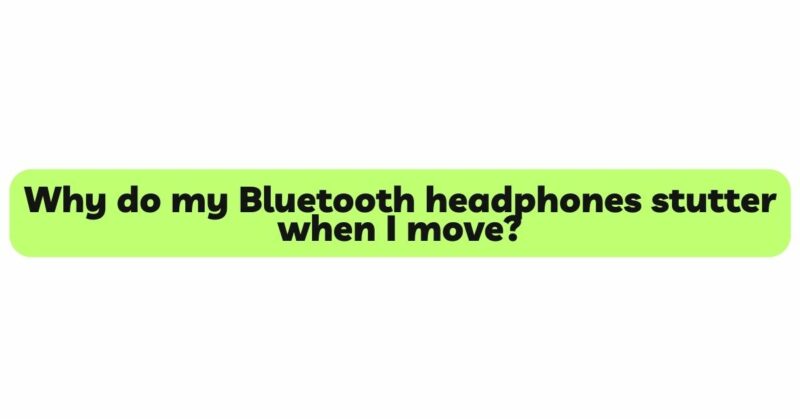Bluetooth headphones have become a popular choice for music enthusiasts, travelers, and fitness enthusiasts due to their wireless convenience and freedom of movement. However, one common issue that users encounter is Bluetooth headphone stuttering when they are on the move. The audio interruptions and sudden breaks in playback can be frustrating and diminish the overall listening experience. In this article, we will delve into the technical aspects of Bluetooth technology, explore the factors contributing to headphone stuttering when moving, and provide practical solutions to overcome the problem and enjoy seamless audio on the go.
I. Understanding Bluetooth Technology and Headphone Stuttering:
Bluetooth technology enables wireless communication between devices, such as smartphones and headphones, over short distances. It relies on radio waves to transmit audio signals from the source device to the headphones. Bluetooth headphones establish a connection with the source device, and audio data is sent in packets to facilitate playback.
Headphone stuttering occurs when there are disruptions or drops in the Bluetooth connection between the headphones and the source device. The interruption in the transmission of audio packets leads to audio stuttering or skipping.
II. Causes of Bluetooth Headphone Stutter When Moving:
- Signal Interference:
Moving from one location to another can result in changes to the environment and the Bluetooth signal’s path. Signal interference from other wireless devices, electronic devices, or obstacles can disrupt the Bluetooth connection, leading to audio stuttering.
- Distance and Range:
Bluetooth has a limited range, typically up to 30 feet (10 meters) in open spaces. When you move away from the source device, the Bluetooth signal may weaken, causing audio interruptions. Additionally, physical barriers, such as walls or doors, can further reduce the signal strength.
- Physical Obstructions:
The human body and other physical obstructions can attenuate the Bluetooth signal. When the headphones’ Bluetooth antenna or the source device is blocked by the body or other objects while moving, the signal may weaken, resulting in audio stuttering.
- Battery Levels:
Low battery levels in either the source device or the Bluetooth headphones can affect the stability of the Bluetooth connection. As the battery depletes, the signal strength may decrease, leading to audio interruptions when moving.
- Signal Congestion:
In crowded environments with many Bluetooth devices, such as public transportation or events, there can be increased signal congestion. Multiple Bluetooth signals competing for the same frequency can lead to interference and audio stuttering.
- Bluetooth Version and Codec:
Using an older version of Bluetooth or incompatible audio codecs can impact the headphone’s ability to maintain a stable connection while moving. Upgrading to a newer Bluetooth version or using supported codecs can improve the audio experience.
III. Solutions to Overcome Headphone Stutter When Moving:
- Maintain Proximity to Source Device:
To minimize audio interruptions, try to keep the source device (e.g., smartphone, tablet) close to the headphones. This will ensure a stronger Bluetooth signal and reduce the likelihood of stuttering.
- Avoid Signal Interference:
In crowded areas with many wireless devices, consider moving away from potential sources of signal interference. Electronic devices and Wi-Fi routers can emit radio waves that interfere with Bluetooth signals.
- Clear Line of Sight:
Maintain a clear line of sight between the source device and the Bluetooth headphones. Avoid placing physical barriers or obstacles that could obstruct the Bluetooth signal.
- Update Firmware and Software:
Ensure that both the source device and the headphones have the latest firmware and software updates. Manufacturers often release updates to improve Bluetooth stability and performance.
- Use Bluetooth 5.0 Technology:
Consider using Bluetooth 5.0 headphones and source devices if available. Bluetooth 5.0 offers improved signal range and reliability compared to previous Bluetooth versions.
- Optimize Codec Settings:
Check the audio codec settings on both the source device and the headphones. Some codecs, such as AAC or aptX, provide better audio quality and stability during movement.
- Minimize Signal Congestion:
Change the Bluetooth frequency or use a different channel in areas with many Bluetooth devices to reduce signal congestion and interference.
IV. Adjusting Headphone Usage Behavior:
- Avoid Sudden Movements:
Try to avoid abrupt and jerky movements when wearing Bluetooth headphones. Sudden movements can temporarily disrupt the Bluetooth signal and cause audio stuttering.
- Secure Headphone Fit:
Ensure that the headphones fit securely and snugly on your ears. A loose fit can lead to temporary disconnection or signal loss.
- Use Clip-on Bluetooth Receivers:
Consider using clip-on Bluetooth receivers or adapters to provide a more stable connection between the source device and the headphones. These accessories can help improve signal reception.
Conclusion:
Bluetooth headphone stuttering when moving can be attributed to various factors, including signal interference, distance, physical obstructions, and low battery levels. Understanding these underlying causes allows users to implement practical solutions to enjoy a seamless audio experience on the go. By optimizing Bluetooth settings, keeping devices in close proximity, and avoiding signal congestion, users can significantly reduce audio interruptions and enjoy uninterrupted music and calls while moving. As Bluetooth technology continues to evolve, future advancements are expected to provide even more reliable and stable wireless audio experiences, making Bluetooth headphones a versatile and dependable companion for users on the move.


